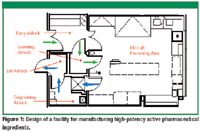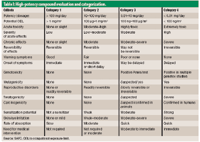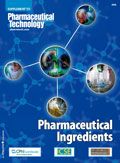High-Potency APIs: Containment and Handling Issues
The author explains the planning, equipment, and facility design requried for manufacturing HPAPIs and specialized requirements for handling these compounds.
A significant proportion of new drugs under development contain high-potency active pharmaceutical ingredients (HPAPIs), which is leading to explosive growth in demand for their production. The cytotoxicity of HPAPIs, however, presents handling challenges and requires heavy investment in specialized containment to ensure that employees and their environment are protected from exposure. This article examines the planning, equipment, and facility design of chemical and biologic HPAPIs as well as biologic–HPAPI conjugate manufacture. It also outlines the efforts made by the pharmaceutical industry to develop voluntary standards for HPAPI production and handling.

SAFC
During the last decade, the demand for HPAPIs has grown rapidly, mainly as a result of advances in clinical pharmacology and oncology research. There is particular interest in HPAPI–antibody conjugate technology, which uses monoclonal antibodies to selectively deliver HPAPIs to specific cancer tumors. When conjugated to the antibody, the HPAPI targets cancer cells specifically and thereby spares nontarget cells many of the toxic effects. Wyeth's "Mylotarg" (gemtuzumab ozogamicin) is an example of such a drug. It is commercialized for treating acute myeloid leukemia, and numerous other antibody drug conjugates are in preclinical or clinical trials.
Compared with the overall growth in the pharmaceutical market of about 7% per year, HPAPIs are estimated to have an annual growth of 12% (1, 2). They account for about 12% of the total pharmaceutical market, and this share is set to rise strongly (3). Although this emerging market is attractive, it presents a significant challenge for pharmaceutical manufacturers to upgrade existing facilities that are set up to handle only nonpotent APIs—the challenge being the major cost associated with the specialized containment needed to ensure that employees and their environment are protected from exposure. Many contract manufacturers are also building new facilities that are designed specifically for the manufacture of HPAPIs, which require an investment of millions of dollars beyond typical GMP (good manufacturing practices) production facilities. This investment may include specialized facilities for HPAPI–antibody conjugations that incorporate both potent-compound handling and biologics processing capabilities.
Definition of HPAPIs
The definition of an HPAPI varies depending on the literature; however, APIs deemed to be potent may fall into the following categories (4):
1. A pharmacologically active ingredient or intermediate with biological activity at approximately 150 μg/kg of body weight or below in humans (therapeutic daily dose at or below 10 mg)
2. An active pharmaceutical ingredient or intermediate with an occupational exposure limit (OEL) at or below 10 μg/m3 of air as an 8-h time-weighted average
3. A pharmacologically active ingredient or intermediate with high selectivity (i.e., ability to bind to specific receptors or inhibit specific enzymes) and/or with the potential to cause cancer, mutations, developmental effects, or reproductive toxicity at low doses
4. Or, by default, a novel compound of unknown potency and toxicity.
The potency of pharmaceutical chemicals is often characterized by OELs in μg/m3; the lower the value, the more potent the chemical and the greater the level of containment that is required. Currently, there is a significant increase in the number of APIs going through development and clinical trials, and into the production environment with OELs well below 10 μg/m3. These processes require specialized containment to ensure that employees and their environment are protected from exposure. Figure 1 shows a facility design of a typical kilo-laboratory (using glassware) for HPAPI handling. The main features are as follows:

Figure 1 (FIGURE 1 IS COURTESY OF SAFC.)
- Room pressure differentials designed for containment (with monitoring and verification), with the main HPAPI-handling area at negative pressure to surrounding rooms
- Airlocks and vestibules around manufacturing and laboratory spaces to provide gowning and degowning areas and proper pressure differentials
- Restricted access to ensure that only the necessary trained employees enter the HPAPI-handling areas
- HVAC (heating, ventilation, and air conditioning) systems designed for single-pass air—no return, with temperature, humidity, and particulate controls
- Misting showers as part of degown and exit vestibules to rinse personal protective equipment (PPE) and gowning prior to removal
- Filtration and capture of contaminants, with safe-change filters, both point source (within the isolator, ventilated enclosure) and the general HVAC exhaust system
- Preventive maintenance and change-control procedures to ensure that equipment and systems continue to operate properly and according to design specifications.
Several factors need to be taken into consideration when planning a facility as outlined below:
- Cleanability, decontamination, and product changeover
- Controlling employee activity in the facility to minimize exposure potential
- Flexibility (i.e., does the design allow for easy reconfiguration?).
Operating an HPAPI facility
Operating an HPAPI facility means that a number of systems, policies, and standard operating procedures (SOPs) must be put in place to protect staff. Additionally, manufacturers must ensure all employees handling HPAPIs be adequately trained. Senior management must support the implementation of such systems, which includes providing the necessary funding for these systems. There should be regular reviews of material safety data sheets, toxicological literature, and relevant occupational safety and health literature for knowledge regarding the compounds used. These reviews should also include information on PPE and engineering processes.
Training. To develop and monitor handling programs and training, it is recommended that a committee be established to take responsibility for HPAPI-handling programs. Ideally, this committee would comprise a mixture of senior management, handling staff, experts, occupational health professionals, and senior scientists. The committee should put together a general company policy and a range of SOPs for potent-compound handling, including details of which staff members have access and are able to handle HPAPIs, training-program requirements, development of SOPs, evaluation, categorization, and updating procedures and processes. For each step, specific written instructions for equipment use and unit operations must be in force, though this could be applied through the use of SOPs.
Occupational safety. One of the primary concerns when handling potent compounds is employee exposure, which could potentially result in undesired health effects and/or sensitization. It is vital to set up an appropriate employee medical surveillance and monitoring program. An occupational physician should work closely with the committee, regulatory authorities, and any relevant health and safety bodies. Another significant issue is the ability to clean contaminated surfaces to an established, acceptable and safe level set out by GMP or industrial hygiene guidelines. Cleaning verification and validation procedures are critical and should include a viable deactivation solution in the cleaning process whenever possible.
Response plans. Response plans must also be in place to ensure employees react appropriately to an unplanned event. These plans should include employee training for emergency response, communication plans, and an ongoing evaluation of the program. Involvement of local authorities in the planning and training for emergency response is also important.
Equipment checks. It is vital that HPAPI-handling systems and equipment are tested and verified to meet the necessary isolation requirements. For example, isolation equipment may be expected to meet a containment capability of less than 1 μg/m3. The capability of equipment, systems, and procedures to contain and isolate materials under expected operating conditions must be verified as a critical component of the overall HPAPI-handling program. This process typically requires the use of both air and surface industrial hygiene sampling methods to confirm proper isolation following a detailed sampling plan. In many cases, sampling and testing methods for products in early preclinical or clinical testing have not been developed. Therefore, surrogate products such as lactose or naproxen sodium, are frequently used to complete the equipment testing.
Compound evaluation. When considering the manufacture of an HPAPI, there must be close evaluation of the compound for potential toxicity, potency, and hazards. The Occupational Safety and Health Administration ensures that employees are provided a safe and healthful working environment, but there is no official guidance about safely manufacturing potent APIs. As a result, the industry has begun policing itself. There are currently two commonly used programs—a five-tiered system such as the one used by Merck & Co., and a more frequently used four-tiered system similar to the one developed by SafeBridge Consultants.
The compound is placed into a potency category based on the available data and evaluation process (see Table 1). The following are attributes that may be considered for each category of compound using the SafeBridge rating system:

Table I
- Category 1: Low potency, higher dosage levels, minimal reversible acute and chronic health effects, good warning properties, no "genic" effects, not a sensitizer, slow absorption, no medical intervention required following exposure
- Category 2: Moderate acute and chronic toxicity, reversible effects, weak sensitizer, fair warning properties, moderate absorption rate, no "genic" effects, may require medical intervention
- Category 3: Elevated potency, high acute and chronic toxicity, effects may not be reversible, moderate sensitizer, poor or no warning properties, quick absorption rate, suspected or known "genic" effects, moderate to immediate medical intervention required
- Category 4: High potency, extreme acute and chronic toxicity, irreversible effects, strong sensitizer, poor or no warning properties, quick absorption rate, known "genic effects," higher degree of medical intervention required, may affect sensitive subpopulations.
This categorization system is referred to as performance-based exposure control limits, which link compound toxicity and potency to procedures for safe handling practices (5). This system was set up in the late 1980s by pharmaceutical manufacturers for handling development projects where insufficient data was available to establish OELs. SafeBridge recommends Category 3 as the default categorization when very little or no information about a compound is available. This requires handling of the material as a potent compound with sufficient engineering controls for containment.
Handling HPAPIs. Engineering controls should be used as the primary source for containment and isolation of potent compounds. Although PPE is also used, it is secondary employee protection for exposure control. The category assigned to the compound defines proper handling procedures as follows:
- Category 1: General laboratory practices and gowning; open handling can be completed for ~ ≤ 1 kg, local ventilation for > 1 kg; no containment.
- Category 2: General laboratory practices and gowning, open handling can be completed for ~ ≤ 100 g, local ventilation for > 100 g; containment for high-energy, dust-generating operations (milling)
- Category 3: Additional gowning and respiratory protection when handling powders; no open handling of powders, additional facility controls for containment, closed-system solution transfers
- Category 4: Full gowning and PAPR (powered air purifying respirator)/supplied-air respiratory protection, no open handling, full containment of all solutions and powders, deactivation solutions for cleaning, specialized facilities.
Potent-compound handling systems should ideally incorporate five levels of cascading protection, the first two being the primary methods of product isolation as follows:
- Process isolation: closed-system glassware and reactors, α/β valves
- Containment equipment: glove-box isolators, ventilated laminar flow enclosures, rapid-transfer ports, local exhaust ventilation, closed-system cleaning via clean in place
- Facility design: air pressurization, high number of air changes, single-pass air, restricted access, airlocks, safe-change filters, misting showers
- PPE: Saranex coveralls and hoods, PAPR or supplied air, proper glove selection, chemical suits when needed for solvents and reagents
- Personnel: training, procedures and policies, education, health monitoring.
Third-party certification.Companies handling HPAPIs should also consider being certified by a third-party organization such as SafeBridge. This certification process allows for all aspects of the potent compound-handling program to be evaluated against current industry expectations by independent experts. As an added benefit, certification can also lead to continuous improvement and evaluation programs designed to ensure advancement of the HPAPI-handling systems. Even if the company chooses not to go through the certification process, they still may choose to have an evaluation by third-party experts as an effective means of identifying gaps or opportunities for improvement in the HPAPI program.
Conclusion
The development and manufacture of high-potency active pharmaceutical ingredients (HPAPIs) requires significant planning, extensive employee training, proper equipment, and facility design as well as implementation of the necessary procedures to safely handle the compounds. The capital investments are significant, and the knowledge gained through experience is invaluable. Robust systems must be employed in all aspects of the HPAPI-handling program, from initial project evaluation through equipment cleaning, to disposal of process wastes. As the number of potent compounds in pharmaceutical development continues to increase, so will the opportunities for HPAPI manufacturers, especially for companies with capabilities in growing niche areas such as HPAPI–antibody conjugation.
David Bormett is director of regulatory affairs at SAFC Pharma, 645 Science Drive, Madison, WI 53711, tel. 608.233.3115, fax 608.233.6873, david.bormett@sial.com
References
1. P. Van Arnun, "Charting API Market Growth and Opportunity," Pharm. Technol. 32 (7), 58–61 (2008)
2. A. Thayer, "Contained Chemistry," C&EN, 86 (24), 17–27 (2008).
3. P. Van Arnun, "Investing in High-Potency Manufacturing," Pharm. Technol. 31 (11), 54–58 (2008)
4. A.W. Ader, J.J. Mason, and J.P. Farris, "Important Elements in Evaluating Contract Manufacturing Organizations," Chem. Today 25 (2), 56–60 (2007).
5. B.D. Naumannet et al., "Performance-Based Exposure Control Limits for Pharmaceutical Active Ingredients," Amer. Indust. Hyg. Jour. 57 (1) 33–42 (1996).

Drug Solutions Podcast: A Closer Look at mRNA in Oncology and Vaccines
April 30th 2024In this episode fo the Drug Solutions Podcast, etherna’s vice-president of Technology and Innovation, Stefaan De Koker, discusses the merits and challenges of using mRNA as the foundation for therapeutics in oncology as well as for vaccines.
Drug Solutions Podcast: Applying Appropriate Analytics to Drug Development
March 26th 2024In this episode of the Drug Solutions Podcast, Jan Bekker, Vice President of Business Development, Commercial and Technical Operations at BioCina, discusses the latest analytical tools and their applications in the drug development market.
INTERPHEX 2025: Use of Walk-In Chambers for Bio/Pharma Development and Manufacturing
April 2nd 2025Sitting down with the PharmTech Group at INTERPHEX 2025, Christopher Murphy, director of Global Business Development and Service Customer Support at Environmental Specialties, discusses the design and critical role of walk-in chambers in the bio/pharmaceutical industry.